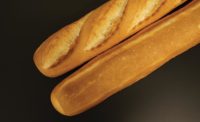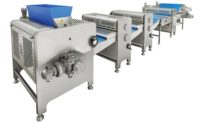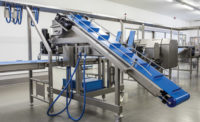Safe and automated dough laminators and sheeters
Snack and bakery companies have advanced options with today’s dough laminators and sheeters.

Automation, ease of operation, simple cleanability, hygienic design, operator safety, and the ability to process nontraditional and healthier ingredients are among the top of mind requests for snack and bakery operators looking to buy or upgrade laminators or sheeters.
Ease of operations is particularly high on the list for customers of Benier, subsidiary of the Kaak Group, Terborg, the Netherlands, says Nigel Morris, head of technology. “It comes down to living with the machinery: How easy is it to operate? How easy is it to maintain and clean?”
Ton van der Pas, team leader for mixers and supportive sales for sheeting lines, adds that Benier customers are also asking about automation and cleaning. “How do you clean the line, how quickly, and how often do you need to clean the line?”
Naegele Bakery Systems, Alsip, IL, which represents the Kaak Group, hears a lot about remote maintenance assistance, says Ken Hagedorn, vice president of sales and a partner. “Your maintenance guy, he can put his goggles on and as long as there’s an iPad nearby, they can go back to the company, whether in Holland or Denmark, and those people back in that country can see what’s going on,” he says.
Cleaning and safety are important to customers of Spooner Vicars Bakery Systems, Grand Rapids, MI, according to Dan Christie, sales manager. “The two kind of go hand-in-hand,” he says. “At least in the first conversation with a customer, you have to have cleaning procedures in place, and then obviously safety is second-to-none,” he says.
Nick Magistrelli, vice president of sales at Rademaker USA, Hudson, OH, says he often talks to customers about operator friendliness. “When the client selects a recipe on the HMI, the line can be equipped with our auto height adjustment feature to automatically adjust the settings in the various sheeting components,” he says. “They can manage controls on their own rather than having to make an adjustment every time the line is different.”
Customers of Moline Machinery, Duluth, MN, would like less operator involvement and greater simplicity, says David Moline, vice president, sales and marketing. “They want a lot of capabilities for maintenance for the advanced user,” he says. “But for the operator, we’ve made efforts to simplify control systems as much as possible, and move the operator changes into the background. It affects how operators have to interact with the line.”
The ability to process doughs made from pulses like lentils, chickpeas, cauliflower or potato are key for customers of Baker Perkins, Peterborough, England, says Keith Graham, business development manager. “These products are increasing in popularity because they add interest and variety to the diet, are gluten free, and may also be perceived as being healthier,” he says.
Richard Breeswine, president and CEO of Koenig Bakery Systems, Ashland, VA, says customers most often ask for features like smaller footprints, hygienic design, and “all-in-one” solutions for different types of doughs. Hygienic aspects in terms of allergens, as well as increased staff safety, are becoming deciding factors for industrial bakeries in the production process, he says.
Equipment innovations
Major suppliers of sheeting lines come to Reiser, Canton, MA, when they need to make precise deposits of expensive ingredients, says John McIsaac, vice president of strategic business development. “It is very common for us to send a Vemag and Reiser engineered depositing system to their factory to prove out an application,” he says. “It allows a customer to confidently order a full system.”
Reiser provides dispensing equipment on sheet lines, and the most common application involves deposits of whatever fat are being used—margarine, shortening or butter—and most commonly on a laminating line, McIsaac says. The Vemag applies a thin, even, accurate sheet as narrowly or widely as needed, with an adjustable shutter that allows for a quick change of thickness. “Simple controls allow the Vemag to be tied into line rate to keep the rate in sync with the dough,” he says. “This assures the correct ratio.”
Kaak Group and Benier offer the DrieM soft dough processing system, which is especially useful for artisan-type bread doughs, Morris says. “What makes it gentle is the combination of the chunking system in the beginning, which can do single or double chunking, so that we don’t actually exert any mechanical pressure on the doughs as they’re coming through the machine,” he says. “We support the dough from the bottom and the sides, all the way through the sheeting process, until the dough gets more body to it and can support itself.”
Benier and Kaak also have developed a full flexible three-roll sheeter that provides for more thickness adjustability by changing all three roller positions independently; it also allows the use of non-fermented doughs as well as water absorption levels of between 42 percent and 70 percent, Morris says. “It’s become an extremely flexible sheeting head,” he says. “We’ve used it for everything from bread-crumb doughs all the way through pizza or flatbread.”
Christie says that Spooner Vicars, which offers the A-PEX 400 series including the Cut Sheet Laminator and Gauge Roll, starts a potential new purchase with a series of questions for the customer: Do they plan to produce laminated or just straight-sheeted products? How much space do they have? Are they replacing an existing machine? How much versatility do they need? And do they need a three- or four-roll sheeter?
In the past few years, Spooner Vicars has worked to change how its machines are cleaned hygienically, focused on ease of access and ease of disassembly, Christie says. “You pull the rollers and deck plates out, and you can change and clean so easily compared to the old lap belt,” he says. “The other thing that differentiates us is that we use chilled cast iron for our roller material. That gives it excellent release capabilities.”
Rademaker USA has made improvements to its machines in areas like sanitation, maintenance, ergonomics and operator friendliness, Magistrelli says. “When you’re interacting with our lines, everything is now equipped with interfaces,” he says. “Our customers want us to look at ways to make the lines simpler to run, to be able to select new recipes and add new products to the line and be able to manage that.”
As a custom-build manufacturer, Rademaker participates in all the different niches, from pastries to pizzas to doughnuts, Magistrelli says. “Each one of those different niches want their own nook and cranny from Rademaker,” he says. “The goal in the future is to create something where there is a series of standard components that would be built in a customized manner for each delivery.”
Moline Machinery is taking sanitary design to the next level, building sheeters intended for daily chemical washdown, with 316 stainless steel on all food contact surfaces and pressure washdown capable components, Moline says. “For the most part, we have standard designs that we customize for the user,” he says. ‘If a baker doesn’t need daily wet washdown construction, they shouldn’t pay for it.”
For flatbread and flour tortillas, Moline has machinery that can run as fast as 180 feet per minute, too fast for operators to react and make changes, but they’re automating a lot of changes that have been operator driven, from forming through cutting, Moline says. The company’s Libra series of sheeters are heavier construction and greater automation than in the past, he says.
Baker Perkins has adopted Internet-of-Things technology as standard for all its machinery and raised the maintenance and hygiene of its laminating and sheeting equipment to the highest standard, which the company dubs TruClean, Graham says. “Bakery Perkins Industry 4.0/IIoT technology allows customers to see trends and manage line performance better,” he says. “We include on-screen machine status and performance information, and maintenance scheduling.”
The TruClean standard reduces maintenance and cleaning time by 40 percent, in line with the quicker changeover times now being demanded by the cracker industry, Graham says. “Features include unique removable side plates on three-roll sheeters, allowing unparalleled access to the ends of rolls for rapid access and cleaning,” he says. “Fitting have been moved outside the frames to give smooth internal surfaces to minimize debris accumulation.”
Koenig offers the Menes-H and Artisan SFM EC dough sheeting lines. The former provides a three-roll dough sheet former with plug-in rollers in different surface finishes that enable both soft and large por doughs to be processed, Breeswine says. The system allows the user to achieve variable widths, and side plates and rollers are easily removed for cleaning and maintenance. The line can process anything from baguettes, to pizza, to sheet cakes, he says.
The Artisan SFM EC, aimed at artisanal bakeries and used for buns and ciabatta, is a gentler system with separate drives for each forming roller in the dough sheet, enabling a homogenous sheet from the beginning and optimized weight accuracy, especially for doughs with high yield and long bowl resting time, Breeswine says. “All small components, such as forming rollers, weighing cells, rounding tolls and stamping tools are easily extractable and changeable without tools,” he says.
Looking for a reprint of this article?
From high-res PDFs to custom plaques, order your copy today!







